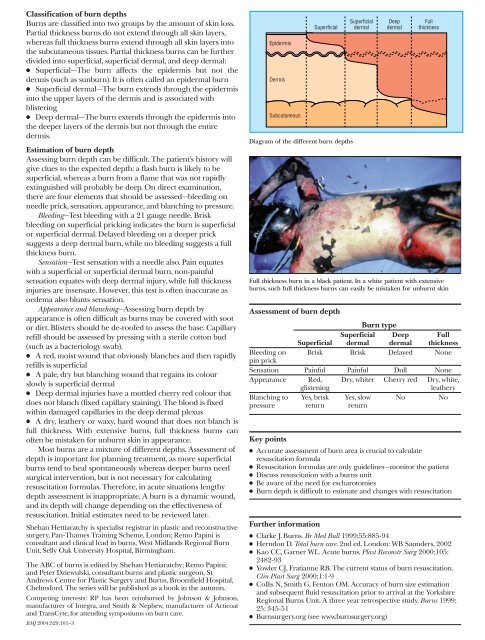ABC of Burns
You also want an ePaper? Increase the reach of your titles
YUMPU automatically turns print PDFs into web optimized ePapers that Google loves.
Classification <strong>of</strong> burn depths<br />
<strong>Burns</strong> are classified into two groups by the amount <strong>of</strong> skin loss.<br />
Partial thickness burns do not extend through all skin layers,<br />
whereas full thickness burns extend through all skin layers into<br />
the subcutaneous tissues. Partial thickness burns can be further<br />
divided into superficial, superficial dermal, and deep dermal:<br />
x Superficial—The burn affects the epidermis but not the<br />
dermis (such as sunburn). It is <strong>of</strong>ten called an epidermal burn<br />
x Superficial dermal—The burn extends through the epidermis<br />
into the upper layers <strong>of</strong> the dermis and is associated with<br />
blistering<br />
x Deep dermal—The burn extends through the epidermis into<br />
the deeper layers <strong>of</strong> the dermis but not through the entire<br />
dermis.<br />
Estimation <strong>of</strong> burn depth<br />
Assessing burn depth can be difficult. The patient’s history will<br />
give clues to the expected depth: a flash burn is likely to be<br />
superficial, whereas a burn from a flame that was not rapidly<br />
extinguished will probably be deep. On direct examination,<br />
there are four elements that should be assessed—bleeding on<br />
needle prick, sensation, appearance, and blanching to pressure.<br />
Bleeding—Test bleeding with a 21 gauge needle. Brisk<br />
bleeding on superficial pricking indicates the burn is superficial<br />
or superficial dermal. Delayed bleeding on a deeper prick<br />
suggests a deep dermal burn, while no bleeding suggests a full<br />
thickness burn.<br />
Sensation—Test sensation with a needle also. Pain equates<br />
with a superficial or superficial dermal burn, non-painful<br />
sensation equates with deep dermal injury, while full thickness<br />
injuries are insensate. However, this test is <strong>of</strong>ten inaccurate as<br />
oedema also blunts sensation.<br />
Appearance and blanching—Assessing burn depth by<br />
appearance is <strong>of</strong>ten difficult as burns may be covered with soot<br />
or dirt. Blisters should be de-ro<strong>of</strong>ed to assess the base. Capillary<br />
refill should be assessed by pressing with a sterile cotton bud<br />
(such as a bacteriology swab).<br />
x A red, moist wound that obviously blanches and then rapidly<br />
refills is superficial<br />
x A pale, dry but blanching wound that regains its colour<br />
slowly is superficial dermal<br />
x Deep dermal injuries have a mottled cherry red colour that<br />
does not blanch (fixed capillary staining). The blood is fixed<br />
within damaged capillaries in the deep dermal plexus<br />
x A dry, leathery or waxy, hard wound that does not blanch is<br />
full thickness. With extensive burns, full thickness burns can<br />
<strong>of</strong>ten be mistaken for unburnt skin in appearance.<br />
Most burns are a mixture <strong>of</strong> different depths. Assessment <strong>of</strong><br />
depth is important for planning treatment, as more superficial<br />
burns tend to heal spontaneously whereas deeper burns need<br />
surgical intervention, but is not necessary for calculating<br />
resuscitation formulas. Therefore, in acute situations lengthy<br />
depth assessment is inappropriate. A burn is a dynamic wound,<br />
and its depth will change depending on the effectiveness <strong>of</strong><br />
resuscitation. Initial estimates need to be reviewed later.<br />
Shehan Hettiaratchy is specialist registrar in plastic and reconstructive<br />
surgery, Pan-Thames Training Scheme, London; Remo Papini is<br />
consultant and clinical lead in burns, West Midlands Regional Burn<br />
Unit, Selly Oak University Hospital, Birmingham.<br />
The <strong>ABC</strong> <strong>of</strong> burns is edited by Shehan Hettiaratchy; Remo Papini;<br />
and Peter Dziewulski, consultant burns and plastic surgeon, St<br />
Andrews Centre for Plastic Surgery and <strong>Burns</strong>, Broomfield Hospital,<br />
Chelmsford. The series will be published as a book in the autumn.<br />
Competing interests: RP has been reimbursed by Johnson & Johnson,<br />
manufacturer <strong>of</strong> Integra, and Smith & Nephew, manufacturer <strong>of</strong> Acticoat<br />
and TransCyte, for attending symposiums on burn care.<br />
BMJ 2004;329:101–3<br />
Epidermis<br />
Dermis<br />
Subcutaneous<br />
Superficial<br />
Diagram <strong>of</strong> the different burn depths<br />
Superficial<br />
dermal<br />
Deep<br />
dermal<br />
Full<br />
thickness<br />
Full thickness burn in a black patient. In a white patient with extensive<br />
burns, such full thickness burns can easily be mistaken for unburnt skin<br />
Assessment <strong>of</strong> burn depth<br />
Bleeding on<br />
pin prick<br />
Burn type<br />
Superficial<br />
Superficial<br />
dermal<br />
Deep<br />
dermal<br />
Full<br />
thickness<br />
Brisk Brisk Delayed None<br />
Sensation Painful Painful Dull None<br />
Appearance Red, Dry, whiter Cherry red Dry, white,<br />
glistening<br />
leathery<br />
Blanching to<br />
pressure<br />
Key points<br />
Yes, brisk<br />
return<br />
Yes, slow<br />
return<br />
x Accurate assessment <strong>of</strong> burn area is crucial to calculate<br />
resuscitation formula<br />
x Resuscitation formulas are only guidelines—monitor the patient<br />
x Discuss resuscitation with a burns unit<br />
x Be aware <strong>of</strong> the need for escharotomies<br />
x Burn depth is difficult to estimate and changes with resuscitation<br />
Further information<br />
x Clarke J. <strong>Burns</strong>. Br Med Bull 1999;55:885-94<br />
x Herndon D. Total burn care. 2nd ed. London: WB Saunders, 2002<br />
x Kao CC, Garner WL. Acute burns. Plast Reconstr Surg 2000;105:<br />
2482{93<br />
x Yowler CJ, Fratianne RB. The current status <strong>of</strong> burn resuscitation.<br />
Clin Plast Surg 2000;1:1-9<br />
x Collis N, Smith G, Fenton OM. Accuracy <strong>of</strong> burn size estimation<br />
and subsequent fluid resuscitation prior to arrival at the Yorkshire<br />
Regional <strong>Burns</strong> Unit. A three year retrospective study. <strong>Burns</strong> 1999;<br />
25: 345-51<br />
x <strong>Burns</strong>urgery.org (see www.burnsurgery.org)<br />
No<br />
No



